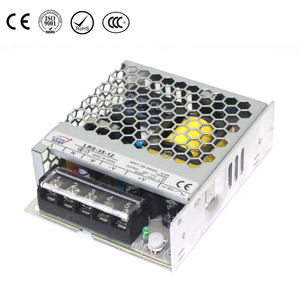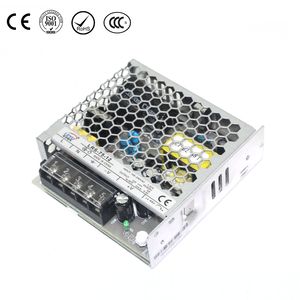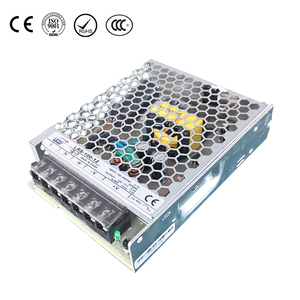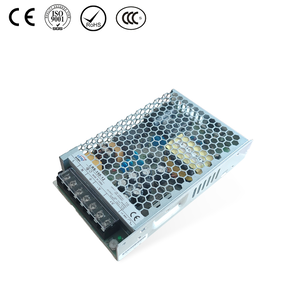Wide Selection of 12 Volt Power Supplies Available
Date:2025-05-13 09:56:22 Visit:610
Finding the perfect 12-volt power supply for your needs can feel like searching for a needle in a haystack. With a plethora of options available, it might be overwhelming to select the right one for your specific requirements. However, the proper power supply is essential to ensure the safety and efficiency of your electronics, whether you're working in industry, using consumer electronics, or diving into automotive projects.
Understanding the fundamental differences and how they compare to 12V batteries will help demystify the world of 12-volt power supplies. These power supplies come in various shapes and sizes. However, all serve the purpose of converting energy to a usable form for your devices. Regulated power adapters, adjustable switching adapters, USB Type C PD adapters, and compact power supplies with selectable output are some of the types you'll encounter.
This guide will walk you through the essentials, from key parameters to working principles, while considering their numerous applications. We'll dive into practical troubleshooting tips and explore what makes a 12-volt power supply reliable. Prepare to embark on an energy-efficient journey, save time, and make informed decisions with our detailed overview of 12-volt power supplies.
Understanding 12 Volt Power Supplies
In today's tech-driven world, 12-volt power supplies play a crucial role in powering a wide range of devices, from household gadgets to industrial equipment. Whether you're running LED lighting, telecommunications gear, or even some types of small appliances, these power supplies are an essential component for providing consistent and reliable power. They convert higher voltage AC power from outlets into lower voltage DC power, which is ideal for many electronic devices. By ensuring stable current delivery, a 12-volt power supply can improve the efficiency and lifespan of your electronic gear.
Definition and Basic Principles
A 12-volt power supply is an electrical device that provides a stable 12 volts of DC output from a higher voltage AC input, typically from a standard wall outlet. It is designed to power various electronics that require consistent low-voltage DC electricity. The core components of a 12-volt power supply include transformers, rectifiers, filters, and regulators. These components work together within a switching power supply system to ensure smooth conversion and regulation of the voltage, accommodating fluctuations in input voltage and loads.
The key elements of a 12-volt power supply are:
- Output Voltage: Delivers a precise 12 volts needed by connected devices.
- Switching Power Supply Mechanism: Improves efficiency by rapidly switching the input voltage on and off.
- Consistency and Reliability: Provides stable power, minimizing risks of damage to sensitive components.
- Compatibility and Flexibility: Suitable for various applications, from home to industrial use.
This technology makes these power supplies essential, especially in environments where reliable power is crucial. They are more efficient and adaptable compared to linear power supplies, and their compact design makes them convenient for different uses.
Comparison with 12V Batteries
While both 12-volt power supplies and 12V batteries provide power to devices requiring 12 volts, they serve different purposes and offer unique advantages. A 12-volt power supply is typically more suitable for prolonged and consistent use where devices are stationary and a constant, stable power input is needed. On the other hand, 12V batteries are portable, making them ideal for mobile or temporary solutions where plugging into a regular power source isn’t feasible.
A 12-volt power supply adapts seamlessly to devices like desktops, security cameras, and routers. It offers adjustable power supply features and, if equipped with Anderson Power Poles, allows for secure and reliable connections. Meanwhile, 12V batteries shine in applications such as camping equipment, emergency backups, or car audio systems, where mobility and independence from a wall outlet are prioritized.
Ultimately, the choice between a 12-volt power supply and a 12V battery hinges on your needs: sustained and stable power from a power supply or portable and situational power from a battery. Understanding your specific requirements can help you decide the best solution for your electronic devices.
Types of 12 Volt Power Supplies
Twelve-volt power supplies are quite versatile and are frequently used for various electronic appliances and devices. They are the lifeline for gadgets ranging from small electronic devices to larger, more complex systems. Among these, there are several distinct types tailored to different applications. Whether you're searching for something regulated or adaptable, each has its unique features and benefits. Below, you’ll find details on various types of 12-volt power supplies to help you make the best choice for your needs.
Regulated Power Adapters
Regulated power adapters are designed to deliver consistent power by maintaining a stable output voltage regardless of fluctuations in input voltage or changes in load. This makes them particularly useful for sensitive electronics that require a reliable supply of electricity to function optimally. One of the main advantages of using regulated power adapters is their ability to provide consistent power, minimizing the risk of damage caused by power surges or drops.
These adapters are essential for devices that voltage irregularities can damage. They ensure longevity and efficient performance for your gadgets. If you need consistent power, a regulated power adapter is often the best choice.
Adjustable Switching Power Adapters
Adjustable switching power adapters stand out for their ability to vary the output voltage as needed. This flexibility allows users to cater to the power requirements of different devices, making them highly versatile. Unlike traditional adapters, these switching power supplies use a high-frequency design, enhancing efficiency and reducing size.
They are perfect for hobbyists and engineers who work with multiple devices requiring different voltage levels. Additionally, the adjustable nature means fewer adapters are needed, saving space and reducing clutter. This makes them ideal for dynamic environments where adaptability is crucial.
USB Type C PD Adapters
USB Type C PD (Power Delivery) adapters have quickly become popular due to their dual capability of data transfer and power delivery. They can supply a variable output, dynamically adjusting to the power needs of connected devices. This makes them particularly efficient for modern gadgets like smartphones, laptops, and tablets.
The USB Type C interface is reversible, providing a user-friendly experience by allowing the cable to be inserted either way. Beyond convenience, these adapters are often compact and lightweight, making them an excellent choice for tech-savvy users who value portability.
Compact Power Supplies with Selectable Output
Compact power supplies with selectable output are designed to deliver the necessary power in a space-saving package. They allow users to manually select the desired output voltage, catering to a diverse array of devices. This versatility is paired with a compact design that saves desk or workspace clutter.
These power supplies are perfect for those who prioritize space without compromising on functionality. Ideal for compact environments, they offer the flexibility of powering multiple devices using a single power supply unit. Furthermore, their design often incorporates active power factor correction, enhancing efficiency and electrical consumption management.
Key Parameters to Consider
When choosing a 12-volt power supply, understanding the key parameters can help ensure you get the best performance and reliability. These power supplies are versatile and used across various applications, from household gadgets to industrial equipment. To make the right choice, consider the power supply’s voltage and current ratings, efficiency and power factor, protection features, and compatibility with standards. Each parameter has a significant impact on the overall functionality and efficiency of the power supply.
Voltage and Current Ratings
The voltage and current ratings of a power supply determine whether it can power your devices effectively and safely. The output voltage should match the requirement of the device you intend to power. More importantly, check the current rating as it indicates the maximum current the power supply can deliver. Always choose a 12-volt power supply with a current rating that meets or exceeds your device's needs to ensure consistent and stable power. Overloading a power supply by drawing more current than it can provide can lead to overheating and potential failure.
Efficiency and Power Factor
Efficiency and power factor are crucial for delivering power effectively while minimizing energy loss. A high-efficiency power supply ensures more electrical energy is converted to power your device, rather than being lost as heat. Alongside, the power factor measures how effectively the power supply uses the current from the AC source. A higher power factor means better energy use, reducing power wasted in the system. Look for power supplies with active power factor correction to enhance efficiency and make the most out of your power consumption.
Protection Features
Protection features are essential to safeguard both the power supply and your devices. A reliable 12-volt power supply should include various protection mechanisms, such as over-current, over-voltage, and short-circuit protection. These features prevent potential damage caused by unexpected surges or faults. For instance, if the current exceeds a specific limit, the power supply will automatically shut down or regulate the output, ensuring the safety of connected devices and users.
Compatibility and Standards
Ensuring your power supply is compatible with applicable standards guarantees safety and reliability. Many 12-volt power supplies adhere to universal standards that facilitate global use and compatibility, particularly with adapters and plug types. Checking for compliance with standards like ISO, CE, or UL can assure you of quality and reliability. Furthermore, consider the type of connection interface, like Anderson Power Poles, for ease of use and flexibility. A power supply compatible with your existing devices and infrastructure will minimize hassle and improve overall efficiency.
Working Principles of 12V Power Supplies
Understanding how 12V power supplies work is critical for anyone dealing with electronics. At their core, these devices transform input voltage from a higher level or alternate current into a stable 12-volt direct current. This consistent power is crucial for many household devices and industrial applications. Because 12-volt power supplies are so versatile, they can be found in everything from computer systems to home appliances. A 12V power supply takes variable input voltage levels. It converts them into a constant, reliable output voltage that's suitable for a variety of uses. This ensures the devices connected to them receive the power they need to operate efficiently.
Circuit Design and Functionality
Circuit design is the backbone of every 12V power supply. It encompasses all the electronic components and wiring that allow the power supply to function correctly. A typical design involves several key elements, such as transformers, rectifiers, and filters. Transformers are responsible for adjusting input voltage levels, making them appropriate for the next component, the rectifier.
Rectifiers play a crucial role by converting AC (alternating current) into DC (direct current). This conversion is vital because most electronic devices work on direct current. After rectification, the power is typically filtered to remove any remaining AC ripple, resulting in a smoother DC output.
A well-designed circuit includes protection features in addition to these components. These can consist of fuses, circuit breakers, and surge protection to safeguard connected equipment against high voltage spikes. Ultimately, the functionality of the circuit design ensures the power supply maintains a stable power output that is safe and efficient for its connected devices.
Voltage Regulation Methods
Voltage regulation in 12V power supplies is fundamental to ensuring a stable output voltage regardless of variations in input voltage or load conditions. There are various methods used to achieve this stability, with each offering distinct benefits.
One standard method is linear regulation. This technique utilizes a series of transistors to control and stabilize the voltage. Linear regulators are highly effective for applications requiring minimal noise and high precise power delivery. However, they can generate significant heat and are not as efficient for high-power applications.
Another widely used technique is switching regulation. Switching power supplies use a different approach by rapidly turning the power on and off. This method is more efficient than linear regulation, as it produces less heat; however, it can introduce more electrical noise.
Lastly, some power supplies incorporate sophisticated methods like active power factor correction (PFC) to improve energy efficiency. This approach adjusts the input current waveform, minimizing energy loss and making the system more efficient. By understanding these methods, you can select a power supply that best fits your power needs.
Common Applications
A 12-volt power supply is an incredibly versatile tool that finds use across a wide range of industries and devices. Its importance cannot be overstated, as many systems and gadgets rely on the stable and reliable power it provides. Whether in homes, businesses, or vehicles, the consistent power output of a 12V power supply ensures optimal performance, making it a staple component in numerous applications. These power supplies are favored for their efficiency and adaptability, able to deliver dependable power under various conditions.
Industry and Manufacturing
In industrial and manufacturing settings, the demand for a reliable power source is paramount. Here, the 12-volt power supply plays a crucial role by powering equipment and machinery that require steady and stable power. Its capability for active power factor correction and adaptable design allows it to accommodate various input voltage requirements. This ensures that tools and machines operate smoothly, minimizing downtime and maximizing productivity. Moreover, manufacturing plants utilize these power supplies to handle tasks like automation processes and control systems, making operations more efficient. The flexibility of switching power supplies also enhances their appeal, as they can manage voltage fluctuations effortlessly, ensuring consistent performance in demanding environments.
Consumer Electronics
The world of consumer electronics thrives on the power provided by 12-volt power supplies. These power supplies are essential for a wide array of devices, from home entertainment systems to computer peripherals. Many gadgets require a universal regulated switching power supply to function optimally, ensuring they receive a stable voltage. The 12V power supply is perfect for these devices, delivering reliable power that supports everyday use. Moreover, devices such as routers, security cameras, and smart home technologies all benefit from the consistent and dependable power output of a 12-volt system. The compact and efficient design of these power supplies makes them an ideal choice for consumer electronics, guaranteeing long-term performance and convenience.
Automotive and Transport
In the automotive and transport sector, 12-volt power supplies serve as indispensable components. Vehicles, ranging from cars to buses, rely on 12V systems to power everything from lighting and air conditioning to advanced navigation systems. The versatile design of these power supplies ensures they can handle the varied and demanding power needs of modern vehicle electronics. With variable output capabilities, these systems can be adapted to power numerous accessories, enhancing comfort and functionality. Additionally, the integration of Anderson Power Pole connections allows for robust and secure connections, critical for ensuring consistent power distribution across vehicle systems. This makes the 12-volt power supply an essential player in enhancing automotive technology and transport efficiency.
Telecommunications
Telecommunications infrastructure depends heavily on stable and reliable power sources to maintain seamless connectivity. Here, 12-volt power supplies provide the backbone for essential equipment such as routers, modems, and signal amplifiers. Consistent power is key to preventing disruptions and ensuring smooth communication channels. The robust and efficient design of these power supplies permits dependable operation, even under fluctuating power conditions. For telecommunications networks, having a stable 12-volt power source enables the continuous and effective operation of various components, supporting everything from data transfer to voice communication services. Whether on a small or large scale, the 12V power supply proves its worth by ensuring networks remain reliable and efficient, contributing to a connected world.
Troubleshooting Common Faults
Issues are not uncommon when dealing with 12-volt power supplies. Whether you're a tech enthusiast tinkering with gadgets or a professional using these power supplies in industrial applications, understanding the common faults can save both time and frustration. Troubleshooting involves a series of checks to identify and rectify these faults. With precise identification, applying effective solutions, and taking preventive measures become much easier, ensuring a stable and reliable power supply.
Identifying Common Issues
The first step in troubleshooting is identifying the typical problems associated with 12-volt power supplies. Faults can be as simple as a loose connection or as complex as a component failure. Common issues include inconsistent output voltage, overheating, and unexpected shutdowns. Each of these symptoms can indicate underlying problems like power surges, faulty wiring, or inadequate cooling. By recognizing these signs early, you can prevent damage to your devices and ensure consistent power delivery. Addressing issues at the initial stage can also avert more significant failures and reduce maintenance costs.
Solutions and Preventive Measures
Once you've identified the issue, finding a practical solution is the next step. For inconsistent output voltage, checking and securing all connections is crucial. If overheating is your concern, ensure proper ventilation and consider using components with active power factor correction for efficiency. For unexpected shutdowns, inspect the input voltage to confirm it's within the specified range. Regular maintenance is vital to prevent recurrence; this includes periodic checks of Anderson Power Pole connections and verifying maximum power output levels. These preventive measures not only mitigate problems but also extend the lifespan of your 12-volt power supplies, ensuring reliable and stable power.
By incorporating these strategies, you can significantly enhance the performance and longevity of your power supplies, keeping your devices running smoothly and efficiently.
Purchasing Reliable 12 Volt Power Supplies
A reliable 12-volt power supply is essential for powering electronic devices. These versatile power supplies are commonly used in a variety of applications, from powering LED strip lights to charging batteries. A 12-volt power supply ensures that your devices receive a consistent output voltage, which is crucial for their efficient operation. Whether you are an electronics hobbyist or a professional, understanding the key features and benefits of 12-volt power supplies will help you make an informed purchase.
Evaluating Trusted Brands
Choosing a power supply from a trusted brand is crucial for ensuring quality and reliability. Trusted brands in the market have established reputations for providing stable and consistent power output. Brands like Anderson Power Products and REL-185 have been known to deliver high-quality products that meet various power needs. These companies often incorporate advanced technologies such as active power factor correction to ensure efficient energy use.
A reliable brand usually offers:
- Stable Power: Ensuring that your devices operate without interruptions.
- Durable Design: Built to withstand everyday wear and tear.
- Customer Support: Provides assistance and solutions if issues arise.
By selecting a 12-volt power supply from a reputable brand, you can be confident in the unit's performance and durability, backed by a company's commitment to maintaining high standards.
Comparing Product Features and Prices
When comparing 12-volt power supplies, it's essential to consider both their features and price points to make the best choice. Some units include adjustable output voltages to cater to different devices. In contrast, others may have Anderson Power Pole connections, making them easy to integrate into existing systems.
Key features to look for include:
- Output Voltage Range: A variable output allows for more flexibility with different devices.
- Maximum Power Output: Helps you determine if the power supply can meet your device's needs.
- Size and Portability: Depending on your application, compact and lightweight designs might be crucial.
Prices can vary based on these features, so it's important to weigh cost against the benefits of the power supply’s capabilities. Ultimately, your choice should align with your specific requirements and budget constraints.
Customer Reviews and Recommendations
Customer reviews are an invaluable resource when choosing a 12-volt power supply. By reading about other users' experiences, you can gain insights into the product's reliability and performance in real-world situations. Reviews can often indicate whether a power supply is easy to use and consistently delivers the desired power output.
Positive reviews often highlight:
- Reliable Power: Customers have had consistently good performance with minimal issues.
- Ease of Use: Users find the installation and setup process straightforward.
- Value for Money: The power supply offers features and quality that justify its cost.
It’s also beneficial to look for any recurring issues noted in reviews, as these can indicate potential drawbacks. Customer recommendations can guide you towards products known for longevity and efficiency, helping you make a choice that ensures satisfaction and reliability in your power supply needs.
Purchase instructions
When purchasing a 12-volt power supply, it's essential to consider a few key details for the perfect match for your needs. Here's a simple guide to help:
- Identify Your Needs: Determine the maximum power output your devices require. This ensures the power supply can deliver consistent power without overloading.
- Check Compatibility: Verify that the input voltage matches your power source and that the output voltage aligns with your device's requirements. Adjustable power supplies can be a versatile choice if you need variable output.
- Connection Type: Consider the connection options, like Anderson Power Poles or USB interfaces, to ensure seamless integration with your devices.
- Power Supply Type: Choose between a DC Power Supply or a Universal Regulated Switching Power Supply. Both offer stable power, but the latter is appreciated for more regulated and reliable power distribution.
- Additional Features: Look for special features like active power factor correction for enhanced efficiency and less power wastage.
- Product Reviews: Checking reviews can provide insights into the reliability and performance of the power supply.
By following these guidelines, you can select a power supply that delivers stable, reliable power to keep your devices running smoothly.




-134213.jpg)



